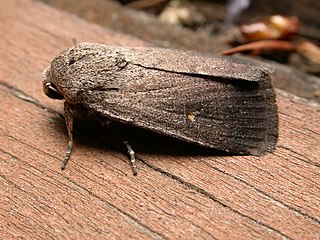
The Catocalinae are a subfamily of noctuoid moths, placed in family Noctuidae. In the alternative arrangement, where the Noctuidae are reduced to the core group around the Noctuinae, the present lineage is abolished, the upranked Catocalini being merged with the Erebini and becoming a subfamily of the reestablished family Erebidae.
Araeomorpha is a genus of moths of the family Crambidae.

Prorocopis is a genus of moths of the family Noctuidae. The genus was erected by Edward Meyrick in 1897. All the species in the genus are known from Australia.

Proteuxoa is a genus of moths of the family Noctuidae. The genus was erected by George Hampson in 1903.

Euproctis is a genus of tussock moths in the family Erebidae described by Jacob Hübner in 1819. Species are cosmopolitan, widespread throughout Palearctic, African, Oriental and Australian regions. Molecular phylogenetic studies indicate that the genus as presently understood comprises a large number of unrelated lineages, only a few of which have names, and is therefore in serious need of revision.

Monopis is a genus of the fungus moth family, Tineidae. Therein, it belongs to the nominate subfamily, Tineinae.
Niguza anisogramma is a moth in subfamily Catocalini of family Erebidae. The species was first described by Oswald Bertram Lower in 1905. It is found in Australia.
Niguza oculita is a species of moth of the family Erebidae first described by Charles Swinhoe in 1901. It is found in Australia, including the Wessel Islands.
Niguza spiramioides is a species of moth of the family Erebidae first described by Francis Walker in 1858. It is found in Australia in the Northern Territory, Queensland and Western Australia.
Discophlebia celaena, the variable stub moth, is a moth of the family Oenosandridae. The species was first described by Alfred Jefferis Turner in 1903. It is found in the south-east quarter of Australia.

Xyloryctidae is a family of moths contained within the superfamily Gelechioidea described by Edward Meyrick in 1890. Most genera are found in the Indo-Australian region. While many of these moths are tiny, some members of the family grow to a wingspan of up to 66 mm, making them giants among the micromoths.

Miscera is a genus of moths in the family Brachodidae.

Procometis is a genus of moths in the family Autostichidae.
Niguza habroscopa is a species of moth native to Australia.








